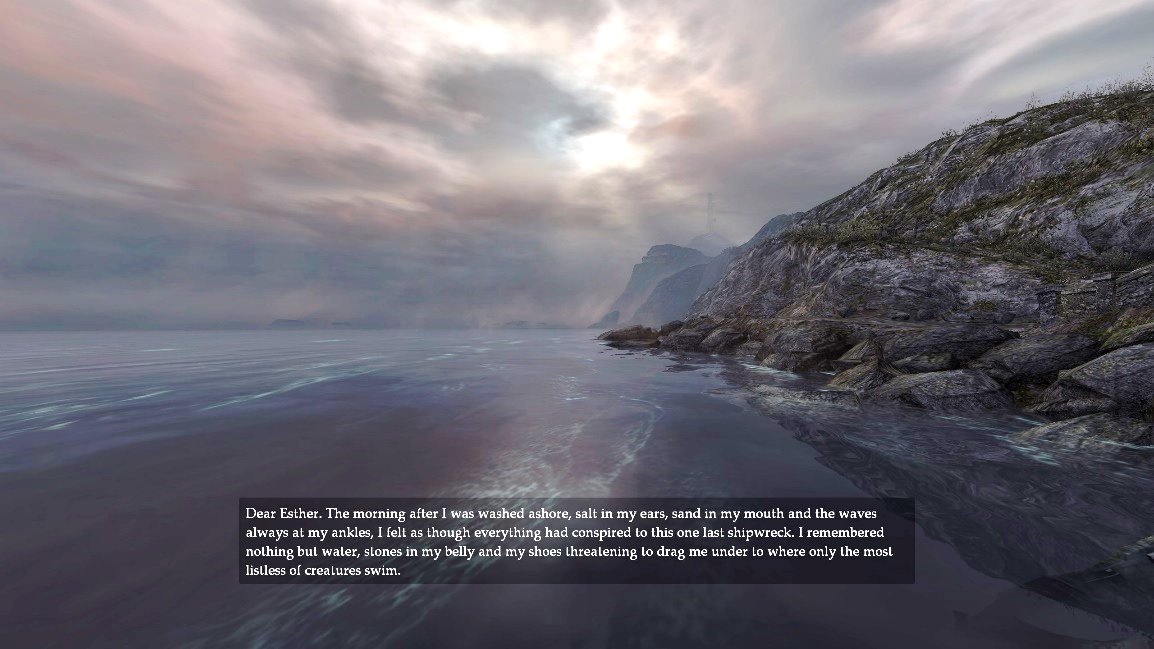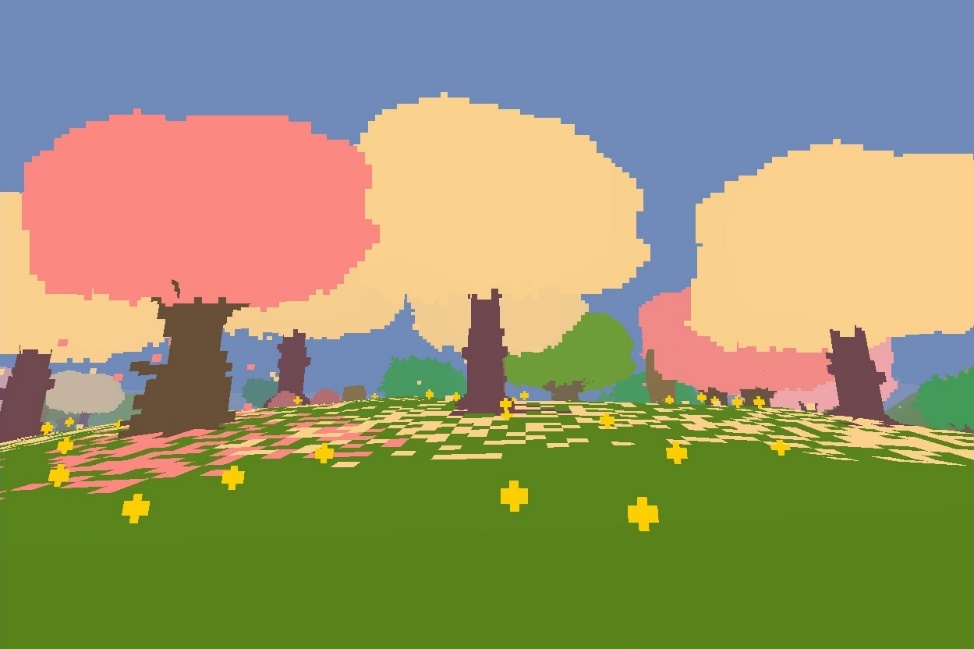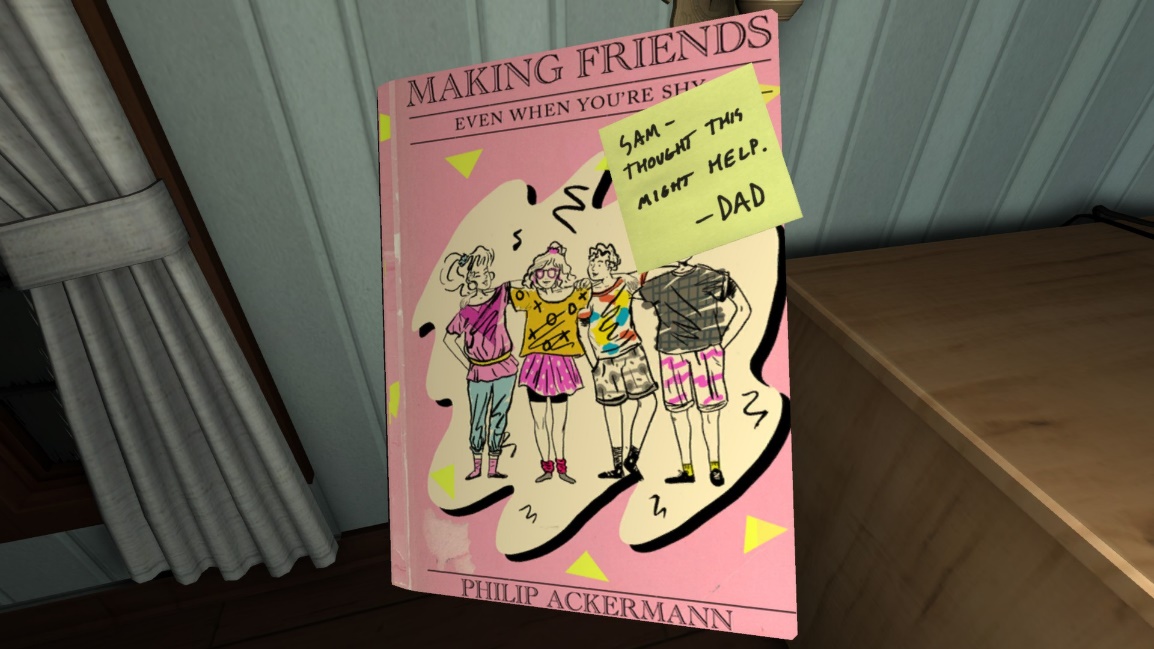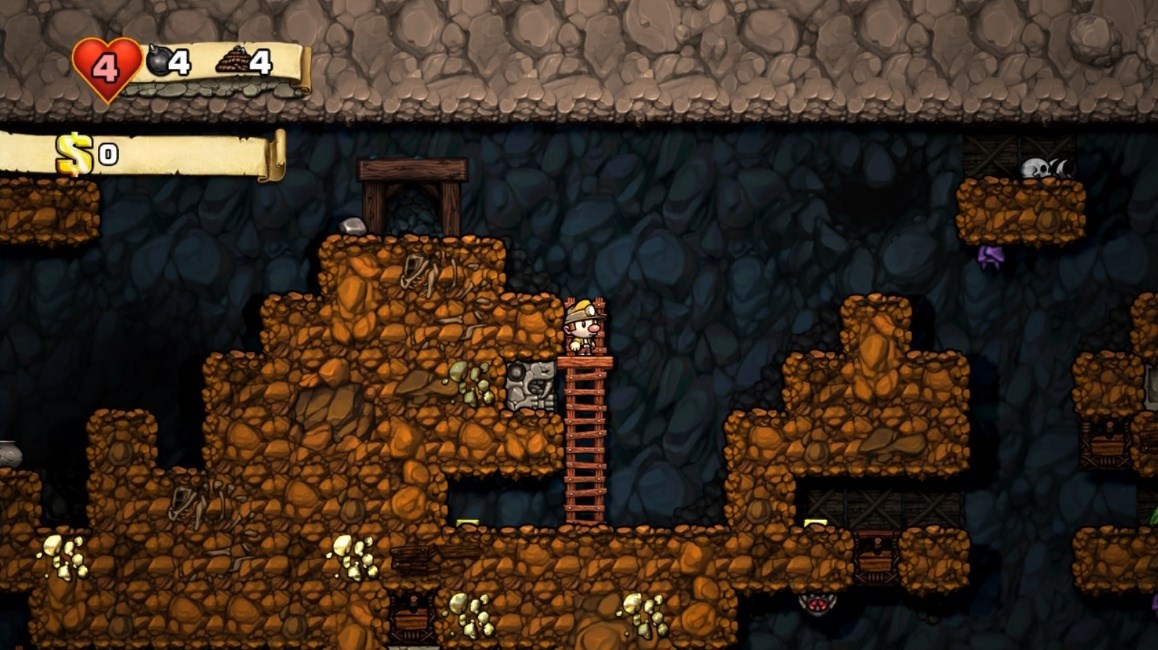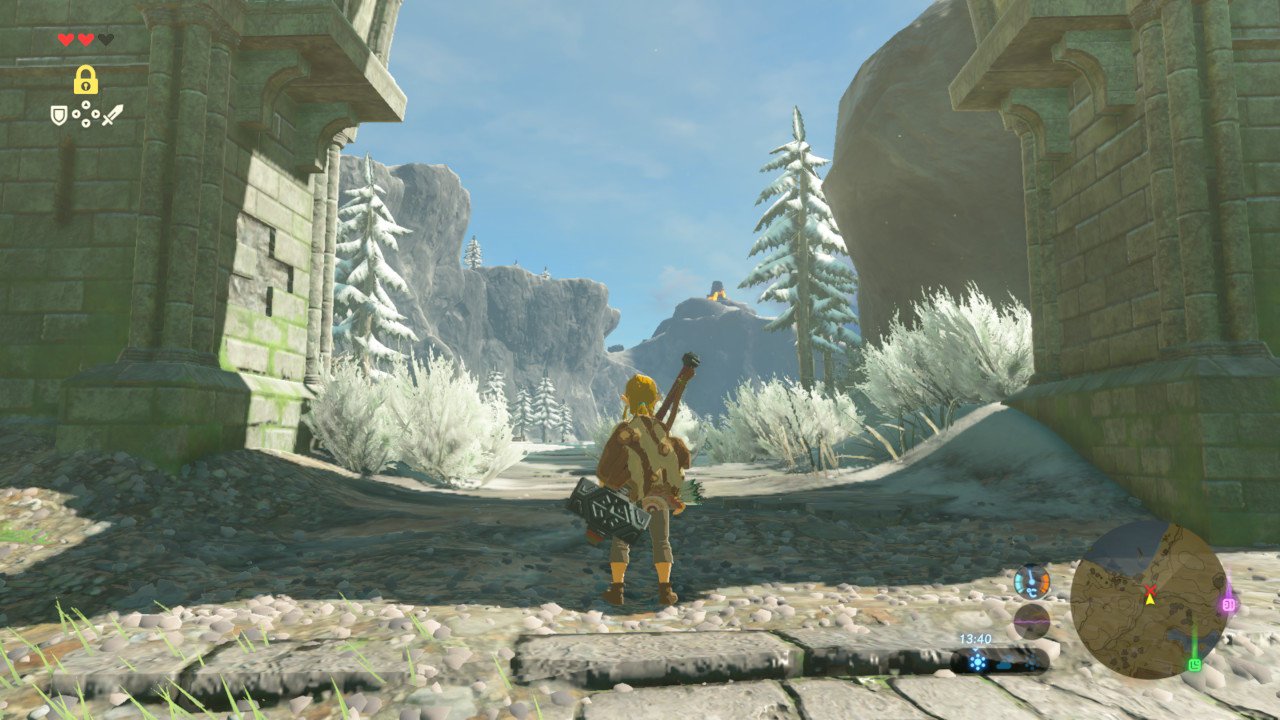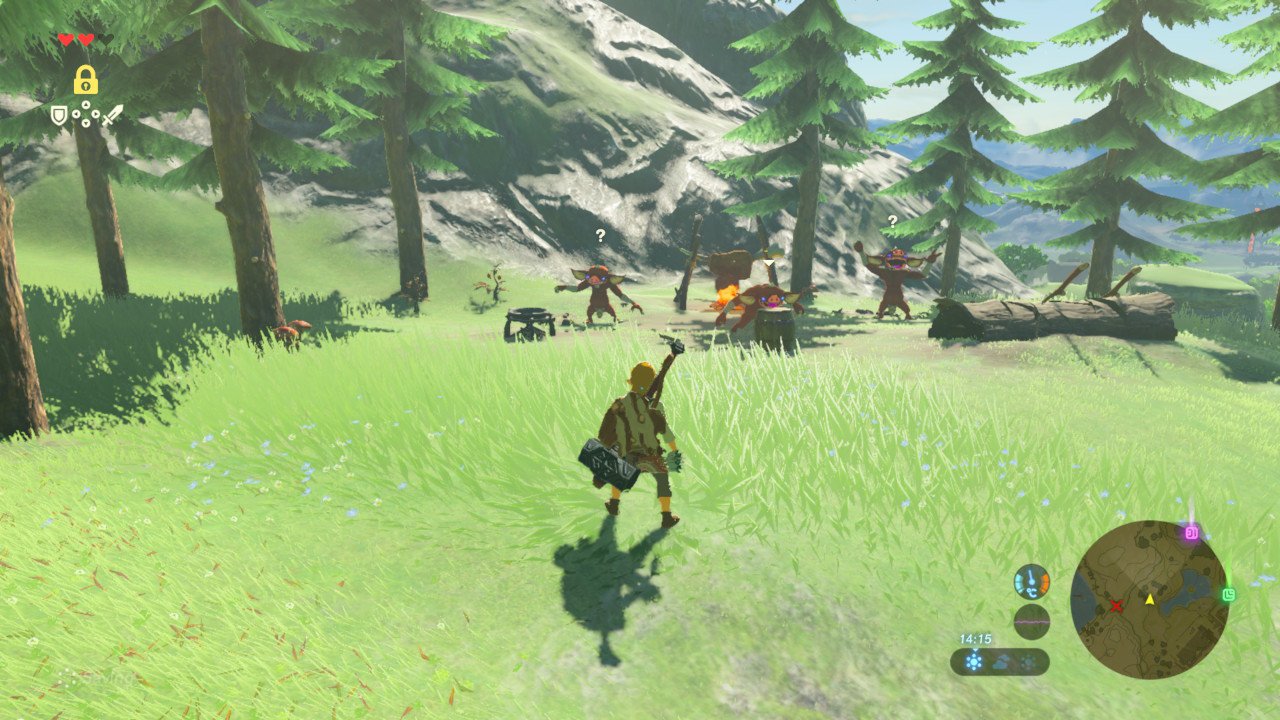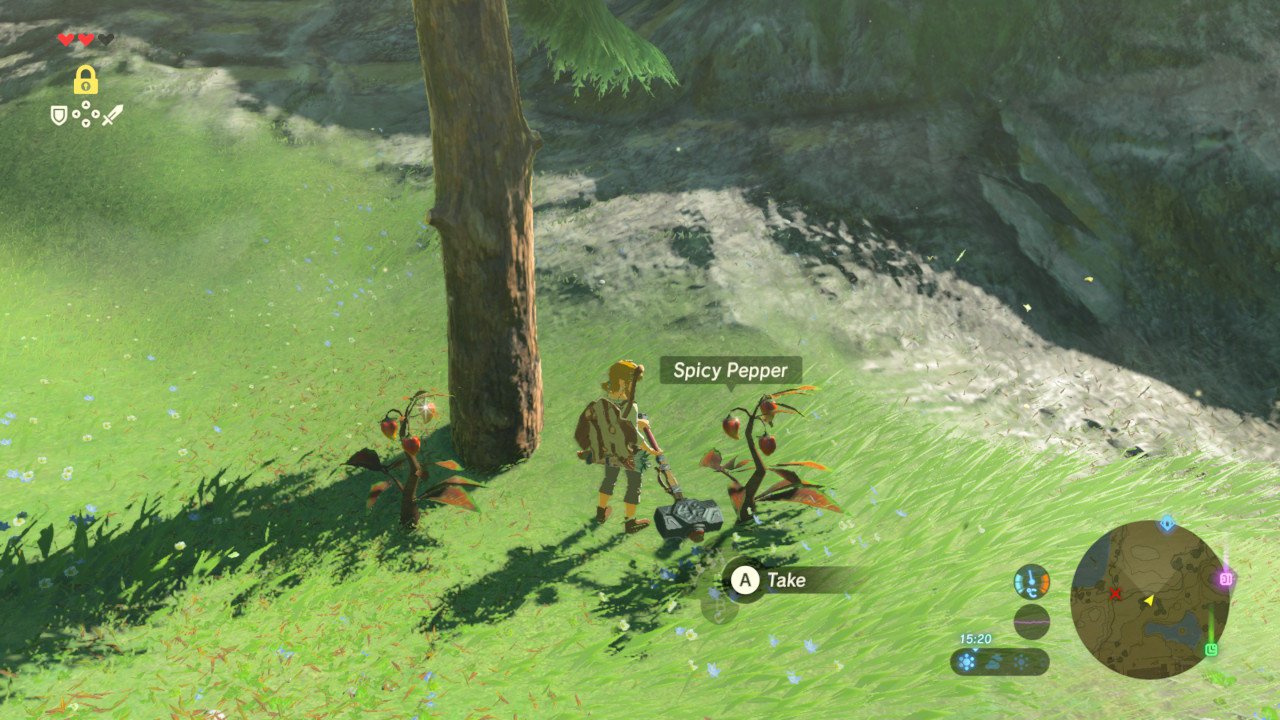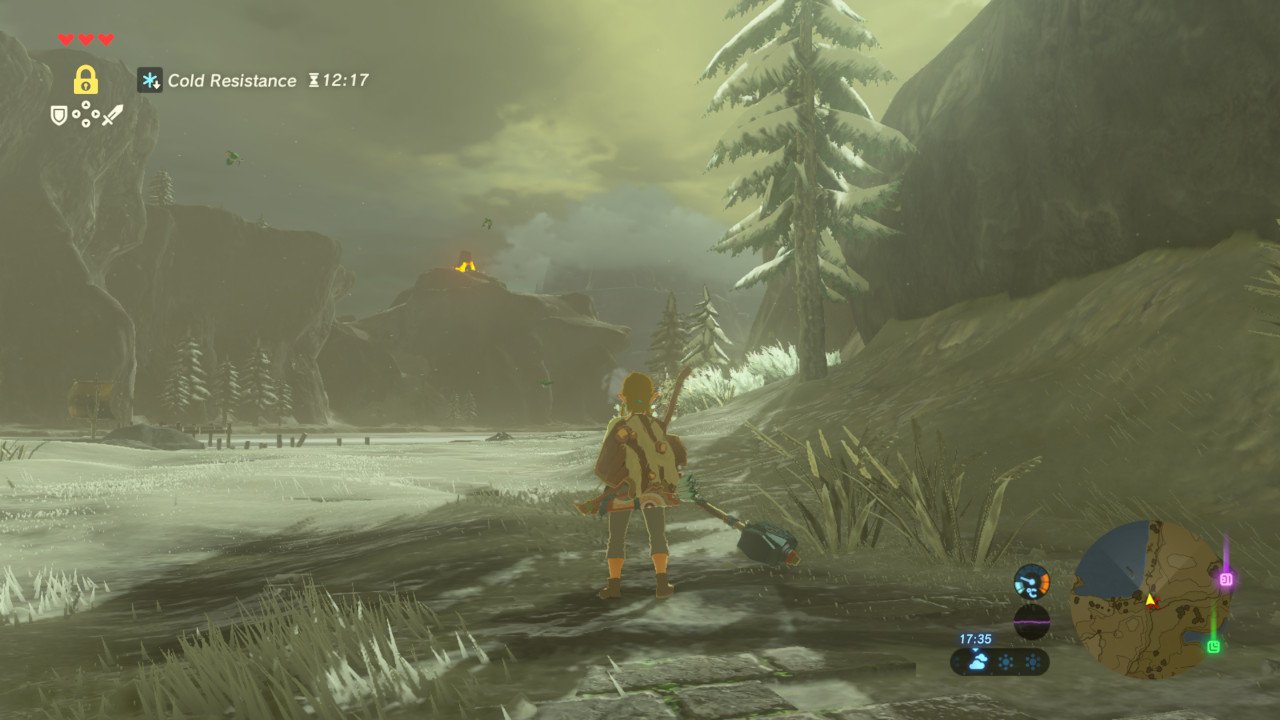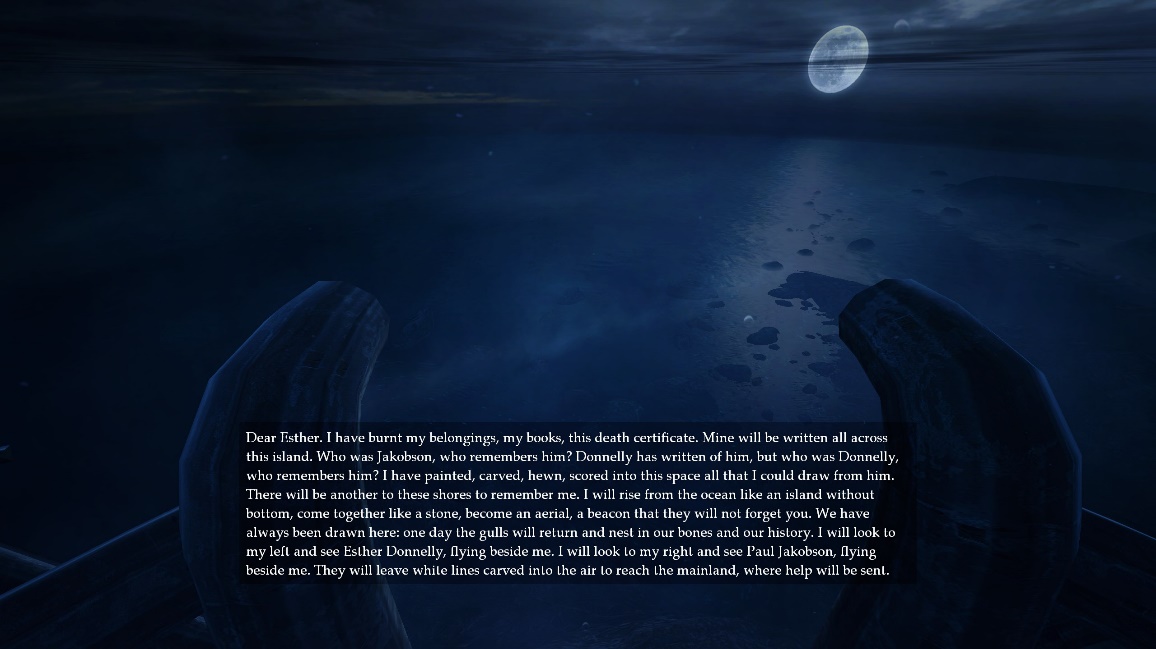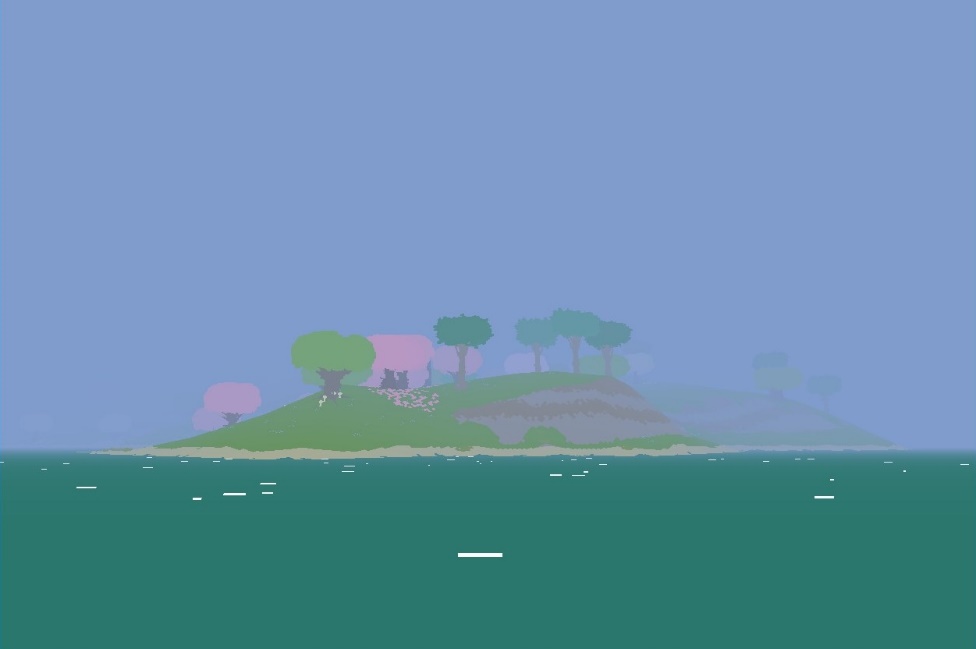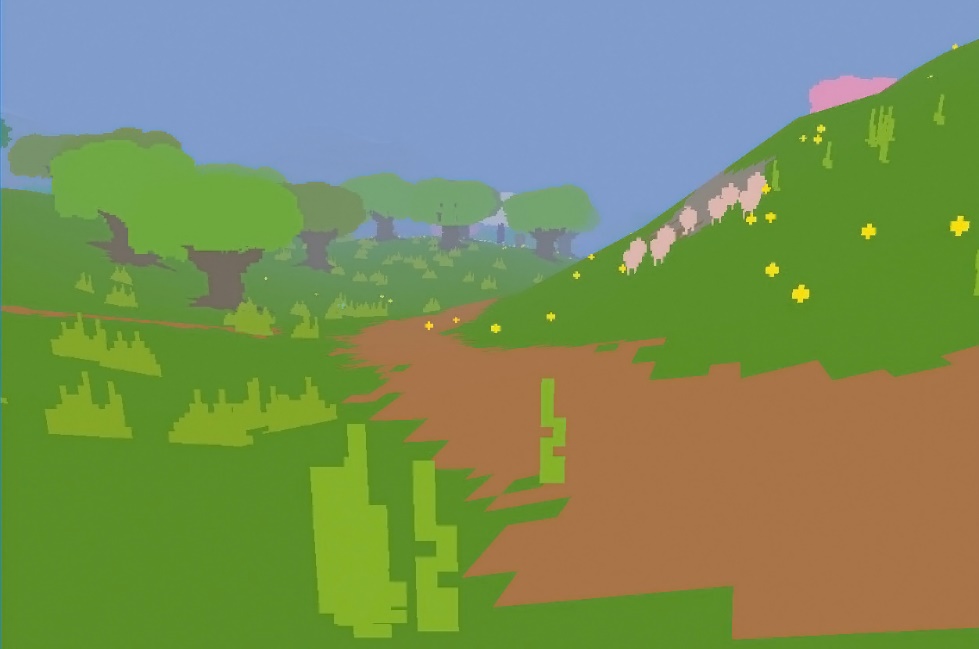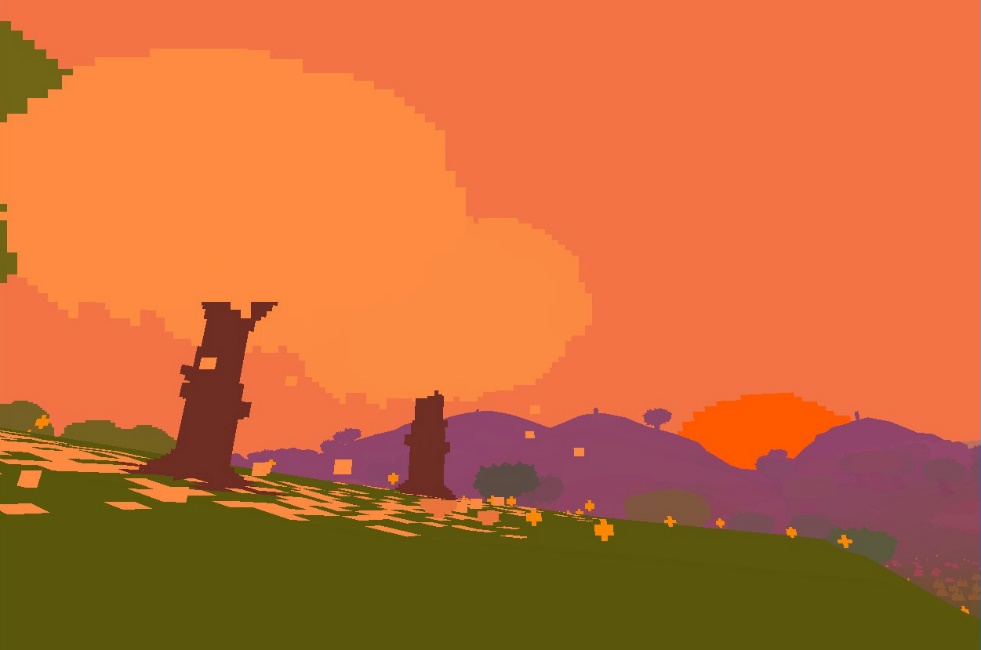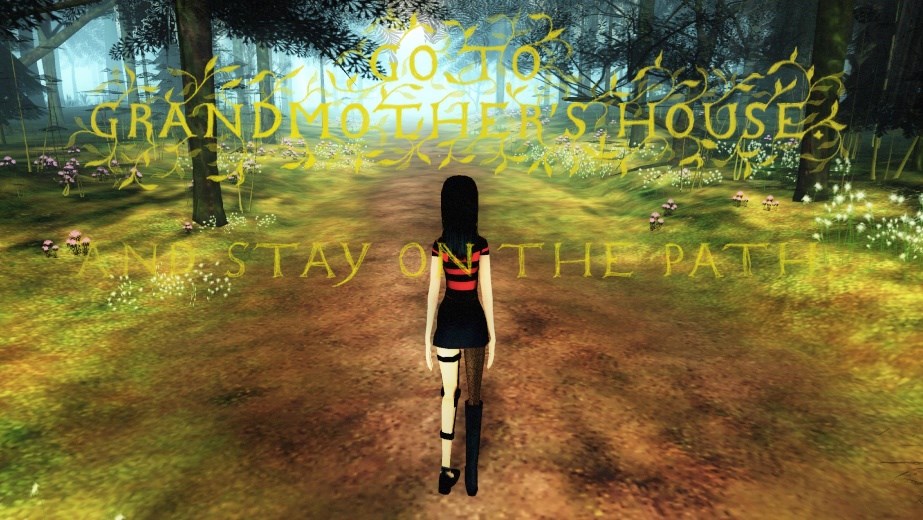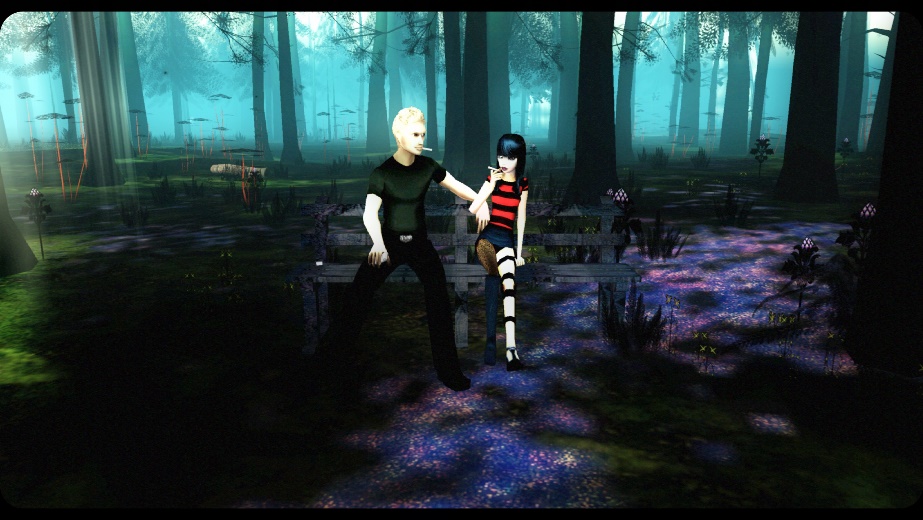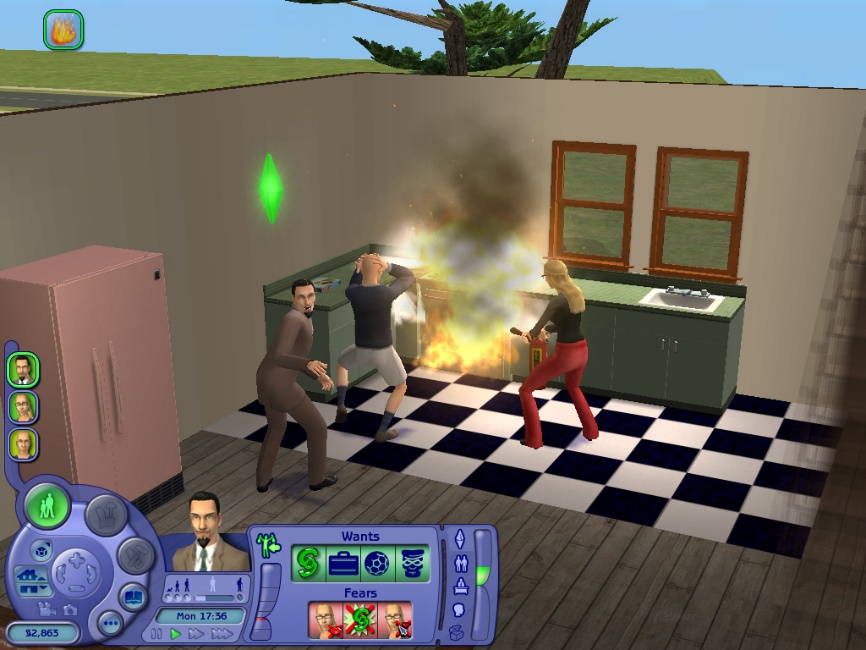The Aesthetics of the Aesthetics of the Aesthetics of Video Games: Walking Simulators as Response to the problem of Optimization
Jesper
Juul: “The Aesthetics of the Aesthetics of the Aesthetics of
Video Games: Walking Simulators as Response to the problem of
Optimization”. 12th
International Conference on the Philosophy of Computer Games
Conference, Copenhagen, August 13-15,
2018.
Figure 1: Dear Esther (The Chinese Room 2012). Walking a linear path, listening to the narrator.
Figure 2: Proteus (Key and Kanaga 2013). Exploring a pastoral and pixelated generated island with little challenge.
Figure 3: Gone Home (The Fullbright Company 2013). Returning to your childhood home to learn of your sister’s life through minimal puzzles. In games, we traditionally expect that the effort we exert will influence the game state and outcome, and we expect to feel emotionally attached to this outcome (Juul 2003) such that performing well will make us happy, and performing poorly will make us unhappy. But a number of recent games, derogatorily dismissed as walking simulators, limit both our options for interacting with the game world and our feeling of responsibility for the outcome. Examples include Dear Esther (The Chinese Room 2012), Proteus (Key & Kanaga 2013), and Everybody’s Gone to the Rapture (The Chinese Room 2015), and Gone Home (The Fullbright Company 2013). “Walking simulator” is a divisive term, originally coined to dismiss these experiences as “not real games” lacking gameplay, thus only simulating “walking”. Developers are divided over whether to reject (KILL SCREEN STAFF 2016) the term or reclaim (Butler 2015 p. 247) it as something positive. Why make such games? Walking simulators are best understood as a response to a foundational contradiction in games: On one hand, games fill the role of aesthetic experiences comparable to other art forms (and art), being quite un-work-like by providing no obvious practical utility. We also assume that we play games for their own sake, and many developers are clear in their ambitions about having video games recognized as an art form. But game-playing tends to involve rationally optimizing our strategy in very work-like fashion, working towards goals, and evaluating game objects exactly for their utility. This makes games a poor fit for the generic template for contemplative art, in part because the rationality and optimization that we employ as players are often thought of as fundamentally inauthentic. This makes it easy for the unadventurous cultural critic to assume as self-evident that playing games is “not a pastime befitting the educated elite” (Parker 2018), in Felan Parker’s paraphrase. Hence: if we want games that function, authentically, as an art form, should we not question how the goal-oriented nature of most games leads us to optimize our strategies? In a radical departure in game history, walking simulators therefore reject the gameplay and strategy optimization that characterize most games, but in doing so, walking simulators present a quite conservative and traditional idea of aesthetics, in order to create video games that can fit in art gallery settings. Figure 1 to Figure 3 show three of the best-known “walking simulators”, Dear Esther (The Chinese Room 2012), Proteus (Key & Kanaga 2013), and Gone Home (The Fullbright Company 2013). To be clear: the word aesthetics has a long history addressed eloquently elsewhere (Levinson 2005) as well as applied to video games (Kirkpatrick 2011). I am not interested in arguing about how define aesthetics in general, but in a specific version of aesthetics that focuses on aesthetic experience as being disinterested, “it does not depend on the subject's having a desire for the object” (Ginsborg 2013) as described by Kant. From this perspective, a work of art may generate excitement, but not a desire for the object. We can think of this more concretely, as a way of behaving towards art and culture. Pierre Bourdieu describes how high culture exhibits a “calculated coldness”, also seen in “the paraphernalia which always announces the sacred character, separate and separating, of high culture-the icy solemnity of the great museums, the grandiose luxury of the opera-houses and major theatres, the decor and decorum of concert-halls.” (Bourdieu 1984 p. 34). Bourdieu in effect conjures up an image of the well-off and well-educated audience, subtly and quietly appreciating fine art, using all the time in the world, while scoffing at the immediacy, “festivity”, and spectacle of popular entertainment (Bourdieu 1984 p. 34). Writing in the tradition of Kant, literary theorist Gerard Genette talks about the aesthetic relation as one where we perceive without regard for utility, without “practical identification” (Genette 1999 p. 7). When engaging aesthetically with something, we do not think of what it can be used for. Genette argues that this aesthetic relation can be both solicited by an artwork – which is designed to give this relation, and triggered by other things, such as nature (Genette 1999 p. 1). Hence, isn’t it strange to discuss video games in this context? Aren’t video games too flickering, with too many explosions, too garish in their colors, too loud, and too rational fit in a gallery? In 2005 film critic Roger Ebert, admitting to only passing knowledge about video games, declared video games to be “inherently inferior to film and literature. There is a structural reason for that: Video games by their nature require player choices, which is the opposite of the strategy of serious film and literature, which requires authorial control.” (Ebert 2005) Ebert’s argument exemplifies an intuition about “art”, as driven exclusively by authorial intent (making art sound eerily like propaganda). In Ebert’s line of thinking, the problem with games is simply that, yes, players do something. Many game developers and players, eager to have their medium accepted as at” were appalled, but one developer stood out: In his 2011 talk “An Apology for Roger Ebert”, veteran game developer Brian Moriarty mounted a defense for Ebert’s claims (Moriarty 2011). Moriarty’s argument builds on quite traditional romantic ideas of aesthetics and art, noting the strangeness of games in this context: Games are purposeful. They are defined as the exercise of choice and will towards a self-maximizing goal. But sublime art is like a toy. It elicits play in the soul. The pleasure we get from it lies precisely in the fact that it has no rules, no goal, no purpose. Oscar Wilde was not being flippant when we [sic] wrote, "All art is quite useless." If the Romantics were right, if the purpose of sublime art is to solve the mystery of choice, it's hard to see how goal-chasing can be anything but a distraction. We can admire an elegant game design from the outside, like a museum game under glass. But once you enter Huizinga's magic circle and start groping at preferences, the attitude of calm, radical acceptance necessary to cultivate insight is lost. (Moriarty 2011) I do not bring out Ebert and Moriarty because it is important that games are considered “art”, given that art is no fixed category, but because Moriarty’s argument is a good example of how traditional aesthetics disagree with the strategy-optimizing side of games. And this is why we have walking simulators: Dear Esther, Proteus, and Gone Home are structured like conventional single-player games where a player works toward a goal, yet players are rarely challenged by the gameplay, and developers argue that by removing the pressure on players to optimize their strategy, these games give players more time to see things. In this paper, I will examine three aesthetic layers of video games, Aesthetics I-III. Aesthetics, again, should be understood broadly, and includes not only the visual side of games, but the experience of playing, such as the typical player activity of working towards a goal, of rethinking and optimizing our strategy. But let me go into more detail with the three layers. Aesthetics I: The aesthetics of video games
Figure 4: Spelunky (Mossmouth 2013). To play is to learn how to avoid the blue bat. The aesthetics of video games: If we play Spelunky (Mossmouth, LLC 2013) (Figure 4) we understand that this piece of software is not to designed to write letters or file taxes, but to play. We use this software for the experience that it gives us, rather than for its practical utility. In Genette’s term, the game solicits an aesthetic response from us. This is the general frame of aesthetics, approaching a game with no expectation of utility (and assuming that it has been designed with this in mind).
Figure 5: Skateboarding at location not designed for skateboarding. (Photo credit: iStock, Arand) The frame of aesthetics, then, has similarities to the notion of play, and play has been invoked by philosophers, especially Gadamer (Malpas 2016), to explain aesthetics (philosophers differ on this issue). But there are two kinds of play here. Play in games, as in the Spelunky example concerns something designed to give an aesthetic response, but in creative play, as shown in Figure 5, the aesthetic relation is triggered by something not designed with that intention. Play is appropriative, says Miguel Sicart (Sicart 2014 p. 11). Creative play repurposes serious things into the non-serious, it takes a serious stair or a handrail, and transforms it into something playful.
Figure 6: Child playing with food. (Photo credit: iStock, phakimata) I can testify to the fact that children will play with food, as shown in Figure 6. The tired parent is exasperated by the child’s disregard of the utility of the food, meant to make the child grow; to make the child healthy. But the child is creative and sees that food can have so many other aspects. It has texture, color, sound, it can be thrown around, you can rub it in your face, it can garner a response from adults. The child engages in creative play by exploring food in ways it was not intended. A large part of socialization is to learn to focus on food for its utility.1 Safety in playHowever, a very hungry child does not play with its food: many definitions of play and games describe play as related to safety. In Chris Crawford’s game definition, safety means that “a game is an artifice for providing the psychological experiences of conflict and danger while excluding their physical realizations“ (Crawford 1984): we may play a game about war, but that does not mean we are physically at war. Similarly, Salen & Zimmerman build on Huizinga to describe the magic circle in which play happens, and which marks the sometimes closed, sometimes open, delineation of game-playing from the rest of the world (Salen & Zimmerman 2004). Martin Burghardt’s work The Genesis of Animal Play: Testing the Limits (Burghardt 2006) describes how animal play only happens in a “relaxed field”, where the animal is not stressed or frightened. It is only when we are not immediately threatened that we can spare the attention to something with no immediate utility, such as a game. This also ties into one of the most basic, and most complex observations about games, and play: that play/games do not have the full weight or impact of regular non-game activities. In his game definition, Roger Caillois, described games as unproductive (Caillois 2001 p. 10) for the same reason. In my own game definition, I used the softer idea of negotiable consequences (Juul 2003), saying that games can be productive, but games are defined by the fact that we can negotiate about the consequences of playing, or winning or losing precisely because the base activity is mostly harmless. In the present day, we are unlikely to see a knife fight as a game, because the core activity is so immediately dangerous2. Aesthetics II: The aesthetics of the aesthetics of video games
Facing an area too cold to enter.
Nearby, a group of bokoblins guard a fireplace.
Having slain the bokoblins, some spicy peppers are conveniently located nearby.
The inventory system helpfully explains the uses of peppers.
A cauldron for cooking is also nearby
Entering the cold area, now with resistance to the cold. Figure 7: Legend of Zelda: Breath of the Wild (Nintendo EPD 2017) The aesthetics of the aesthetics of video games: But we navigate game worlds with the expectation that they have been designed with goal-oriented behavior in mind. The Legend of Zelda: Breath of the Wild (Nintendo EPD 2017) situation shown in Figure 7 is not a natural occurring arrangement of objects but deliberately designed. Right next to an area too cold to enter, a group of bokoblins have clearly been placed by a level designer such that they guard some also deliberately placed spicy peppers next to a deliberately placed cauldron needed to cook said peppers – all in order to make Link resistant to cold for a while so he can enter the area. To play Zelda is to continually interact with the game objects, to build and develop hypotheses about tactics and strategies. At first, we must internalize the range at which the bokoblins are triggered and start attacking and plan the approach accordingly. Then we must learn to use bombs, bows and other items according to the situation. We cannot get far in the game without learning, planning, and optimizing our strategies as we work towards the goal. This is the standard for video games (and for most analog games and sports). This makes video games entirely different from the aesthetic objects that I discussed first: when playing games, much of our energy is spent rationally optimizing our strategies under time pressure. If we think of the prerequisites for both play (feeling safe) and for the aesthetic relation (not being forced to attend to practical utility), we can see inside a game, we are mostly not safe – the bokoblins and the cold will kill us, after all – and we often have little time to relax, or to look at game objects for anything but their practical utility in the game. Deeper and more detailed instances of optimization are easy to find in the community around multiplayer games such DOTA 2 (Valve Corporation 2013) or StarCraft II (Blizzard Entertainment 2010), and the literature on the obsession with strategies in games goes back to at least Pilgrim in the Microworld (Sudnow 1983) on Breakout, and to Stefan Zweig’s 1942 novel Chess Story (Zweig 2011). Indeed, many game communities are based on theorycrafting, the practice of, in a semi-scientific fashion, to understand the inner workings of a game such that players can perform better (Wenz 2013). Games, then, are designed for goal-oriented behavior in which we evaluate the game’s objects for their utility: what can the Spelunky objects do for us? In her study of players of the EverQuest MMO, T.L. Taylor noted how players would talk about their game-playing in ways that were quite work-like: The simple idea of “fun” is turned on its head by examples of engagement that rest on efficiency, (often painful) learning, rote and boring tasks, heavy doses of responsibility, and intensity of focus. Indeed, many power gamers do not use the term “fun” to describe why they play but instead talk about the more complicated notions of enjoyment and reward. At times it almost appears as if they are talking about work. (Taylor 2006 p. 88) Similar things of have been said of World of Warcraft, as “clearly a kind of work” or a “capitalist fairytale” (Rettberg 2008). The strange thing is that the goal-directed behavior is in turn understood to be ultimately goal-less (because a game serves no apparent purpose), escaping practical identification as much as the game as a whole escapes practical identification. Games make us focus on optimization and utility-seeking when playing, but also prompt us to see this optimization and utility-seeking as an experience for its own sake.3 This tension was noted already by Dutch play theorist Johan Huizinga around 1940, describing play as both “not serious” and absorbing: … a free activity standing quite consciously outside "ordinary" life as being "not serious", but at the same time absorbing the player intensely and utterly. (Huizinga 1950 p. 13) Some decades later, French play theorist Roger Caillois elaborated on Huizinga’s observations, placing all play activities on a scale from paidia, free and improvised play, to ludus, the opposite of play, ordered and structured according to rules. In Caillois’ view, the freeform paidia is “absorbed” by the ordered ludus (Caillois 2001 p. 13). Finally, the tension between freedom and constraint in games is captured in the play definition of Salen & Zimmerman, who describe play not as free, but as “free movement within a more rigid structure.” In their take, play has a dual nature to the structure of a system such as game: “play exists because of more rigid structures, but also exists somehow in opposition to them.” (Salen & Zimmerman 2004) 4. The problem with goalsBut what is the problem? According to developer duo Tale of Tales, the problem is that game structure – failing, succeeding – forces us to optimize, and thereby to shift our focus away from the game content that Tale of Tales find interesting. If we create a virtual world, we don't want people to ascend to that systematic level and game the system. We want them to stay in that world with all its problems, and all its ambiguity, and all its strangeness because that's what we find interesting.5 The criticism of player optimization goes beyond video games: Nobel prize winner Yasunari Kawabata’s 1951 novel The Master of Go concerns a final match of Go between the old master and his young challenger. The semi-autobiographical narrator feels that the younger player plays merely for winning and ignores the rituals and dignity of the game: It may be said that the Master was plagued in his last match by modern rationalism, to which fussy rules were everything, from which all the elegance of Go as art had disappeared, which quite dispensed with respect for elders and attached no importance to mutual respect as human beings. From the way of Go the beauty of Japan and the Orient had fled. (Kawabata 2006 p. 57) Go is seen as a game of beauty and ritual, but these values are threatened by the younger player who simply tries to optimize a strategy in order to win. As Andrew Feenberg writes, the match “marks the breakdown of an older vision of the game as a spiritual discipline and the emergence of a new one in which it is essentially a test of strength.“ (Feenberg 1994 p. 120)
Figure 8: New Games Movement game of Knots (Rush n.d.) Is this a problem with games as such, or can it be fixed? From the early 1970s, the New Games Movement (New Games Foundation 1976) experimented with creating communal games, analog, often outdoor games such as Knots shown in Figure 8. These games would sometimes be competitive, but the selection of a single winner was generally avoided. Designer Bernie DeKoven argues that such games exist because the focus on winning can be to the detriment of the community of players: When
you try to win, when winning becomes your goal, it becomes difficult
for you to validate the conventions of our play community. You begin
to evaluate how well-played a game is in terms of who won. If you
won, it was a good game. The point of Bernie DeKoven’s game design philosophy is to give ourselves the opportunity to play, because playfulness is a natural state that we have deprived ourselves of. For DeKoven, the problem with playing to win is that communal playfulness is lost. Even more broadly, Paolo Pedercini claims that “Computer games are the aesthetic form of rationalization” and calls for games that eschew rational instrumentality and its connection to bureaucracy and systems of control (Pedercini 2017). For Pedercini the problem is not that goals make players focus on the wrong things while playing, but that games embody problematic aspects of our contemporary lives. Pedercini’s point ties to how rationality and optimization are often understood as enemies of authenticity, because of a discomfort with the idea that humans are, or can behave as, machines. In Sincerity and Authenticity, Lionel Trilling identifies how the machine has been associated with inauthenticity (Trilling 1973 pp. 126–127). Charles Taylor makes a similar point, singling out instrumental reason as behind the (assumed) disenchantment of the world, as the force that breaks traditional order and meaning, as we also saw in the Kawabata example: The disenchantment of the world is connected to another massively important phenomenon of the modern age, which also greatly troubles many people. We might call this the primacy of instrumental reason. By "instrumental reason" I mean the kind of rationality we draw on when we calculate the most economical application of means to a given end. Maximum efficiency, the best cost-output ratio, is its measure of success. … Once society no longer has a sacred structure, once social arrangements and modes of action are no longer grounded in the order of things or the will of God, they are in a sense up for grabs … The yard stick that henceforth applies is that of instrumental reason. (Taylor 1992 pp. 4–5) The dual worries about goals and optimization in video games, are 1) that they shift the player’s focus away from the game world, and 2) that they make us behave according to a rational instrumentality, the mode of thinking that makes us live inauthentic lives, deprives us of communities, traditions, norms, and disenchants the world.6 Again, this is not the only possible conception of authenticity, but at the present time, Trilling and Taylor’s point resonate, whereas alternative celebrations of automation, of the machine, such as those made by the futurists (Trilling 1973 p. 127), are quite rare. Aesthetics III: The aesthetics of the aesthetics of the aesthetics of video games
Figure 9: Dear Esther: car crash dream sequence, dissolution of narrator The aesthetics of the aesthetics of the aesthetics of video games: Which brings us to the third layer of aesthetics, where designers remove rational utility-seeking and optimization. As a sum-up: stop and smell the roses. This Aesthetics III, the aesthetics of the aesthetics of the aesthetics of video games is a reaction to the contradiction just discussed; an attempt at fixing games such that they become a better fit for our templates of aesthetics, and art. Dear Esther (Figure 1) at first looks like a conventional first person-shooter. Playing on a PC, you move around a Hebridean island in the first person, using traditional WASD and mouse controls. The graphics are 3-dimensional, and even uses the Source engine, designed for first person shooters (FPS). The voiceover, however, addresses the titular Esther in heavy metaphorical language, intermingled with the history of the island. According to FPS conventions, navigation in the game world should quickly give the player access to a weapon and introduce enemies, but this does not happen. Later in the game (Figure 9), the narrator hints at a traffic accident involving, and killing, Esther. This seems to be confirmed by a dream sequence, and when the player finally reaches the top of beacon already visible in the very first image, the player character jumps and apparently commits suicide, flying over the ocean. Are the player and the narrator one, reminiscing about the car crash, and finally jumping from the beacon? The narrator is unusually eloquent and speaks from a position quite distant from the player character walking around the island. In single-player video games, we expect a sense of identity between the player and the game protagonist, signaled by players referring to the in-game protagonist as “I”, but here it is unclear to which extent I am the character speaking. The game does not give us any tools for interacting with the game world beyond walking, and does not develop (Anthropy & Clark 2014 Chapter 2) walking such that it allows us to do new things or learn new skills. Again, this game does not follow the classic game model (Juul 2003), of allowing players to fail or succeed, of feeling responsible for the game’s outcome. But do we get something in return for giving up these conventional sources of enjoyment in a game?
Figure 10: Proteus (Key and Kanaga 2013). Pixelated pastoralism. Arriving to a new island; following mysterious creatures; watching the sunset and leaves falling This third layer, the aesthetics of aesthetics of aesthetics is not, as we might first think, about going back to play, letting players be creative in an open universe. It is the reverse: it is about keeping almost all of game structure, keeping goals and “winning”, but removing the element of games where players improve their skills, where they improvise creatively, where they play. Compare Dear Esther to Proteus, shown in Figure 10, which affords the player more exploration than does Dear Esther. Here, the player arrives at a new random-generated island and can explore the generated pixelated 3d landscape with accompanying music, discovering flora and fauna. Proteus does let the player trigger various events but gives players few tools for interacting with the game world. While the two games are similar in that they can be “completed”, a game of Proteus ends when the player through exploration has triggered all four seasons of a year, after which we are returned to the title screen. It is possible to become “better” at Proteus by learning to trigger the season changes ever faster, but this is not encouraged by the game. Gone Home (Figure 3) is more traditional in that while it allows for completion and offers a few puzzles, it offers little resistance to completion, and the majority of the experience is about learning about the player character sister’s life through left-behind notes and artifacts, rather than about solving problems.
Figure 11: The Path (Tale of Tales 2009). We are told to stay on the path, but the main game only happens when departing from the path, leading to excitement and danger. Tale of Tales’ Little Red Riding Hood-inspired The Path (Tale of Tales 2009) (Figure 11) predates the walking simulator label, but shares with the other games the idea that minimizing the challenge of the game allows a shift of emphasis from challenge to story and environment. Still The Path is less linear than the other games discussed here, and the full game is only revealed if players depart from “the path”, leading to both exciting and dangerous situations.
Figure 12: Firewatch. (Campo Santo 2016). A mostly linear game about mid-life crisis, with a modicum of challenge. Also a game about boredom and loneliness, the only human connection through a walkie-talkie. As a final example, Firewatch (Campo Santo 2016) (Figure 12) is similar to Gone Home in featuring a small measure of challenge, yet Firewatch takes place in the present tense, rather than as an exploration of the past. Firewatch co-designer Chris Remo has explained how their reasoning was that “The game’s mechanics should only really be what the game’s theme demands” (Remo 2018). When the game’s environment suggested challenge and exciting battles according to game conventions, the developers rejected them if they did not fit the game theme. These five games exemplify the open and poetic possibilities of Aesthetics III. Recall how Burghardt argued that safety was a prerequisite for play: when challenge is removed, the player has mental resources available for other tasks. This mirrors poetry or cinema, where removing the expected structures such as sentences or plot, users will be made to approach the work in a more poetic way, be more open to allusions, wordplay, and subjective experiences, yet walking simulators eschew actual play in favor for the poetic or associational. Note also that Aesthetics III is made possible conceptually by the realization that games do not have to be fun, but can engender many different kinds of experiences, as argued by Hunicke et al. (Hunicke et al. 2004) and Tracy Fullerton (Fullerton et al. 2004). Tale of Tales argued that goal-oriented games limit the experiences we can have because they make us focus on the wrong things. Pedercini made a more political claim, that because current games are built on and promote problematic ideas, new games must be made to remedy this. Hence Pedercini’s argument assumes instrumental rationality to be an inauthentic substance that should be avoided as such. There is a strength to this argument, but even if we accept its premise (instrumental rationality as a problem) we could make the reverse argument that games shouldn’t be models of a “better world,” but should incorporate and reflect the world as it is. The argument for removing goals and optimization from games refers directly to the traditional idea of aesthetics, according to which games become aesthetics objects and, perhaps, art only if we tone down goal-orientation and let players play in a disinterested way. This is also illustrated by a Rosa Carbo-Mascarell’s interpretation of “walking simulators” as Situationist dérives, the “digitisation of an aesthetic practice” (Carbo-Mascarell 2016). Along similar lines, Olli Leino has argued that art games in general and walking simulators in particular are “refusing to submit the meanings they contain to the instrumental-rational logic subordinated to survival, a logic which first sorts everything in terms being ‘useful’ or ‘harmful’ and renders whatever remains ‘meaningless.’” (Olli 2013 p. 12). When players are neither threatened nor given the chance to operate on the game world, they are free to experience the artifact of the game in more open ways, but they are also denied the experience of interaction including, Leino argues, the types of experiences found in interactive and participatory art. This demonstrates how the newness of walking simulators in a video game context is tied to a conservatism in art and aesthetics. In this way, games and art are running in opposite directions: the video games discussed here attempt to borrow from traditional art, but a sizeable portion of art history concerns artists borrowing from games, in order to break up the assumptions of traditional art, notably in Fluxus, Dadaism, performance art (Flanagan 2009). Developer Zach Gage argues that his practice of making playable and popular games connects to conceptual art and Fluxus – walking simulators are only necessary for one particular conception of art7. Walking simulators vs. free-form playI need to make a distinction: Walking simulators are not the only game type with a strange relation to goals and challenge. I have elsewhere discussed “games without goals” (Juul 2007), and argued that The Sims and the Grand Theft Auto series (Figure 13) both allow us to set our own goals and choose the kind of game we want to play. The Grand Theft Auto games can be completed, but we are free not to pursue these goals; The Sims let us set their own goals. In effect, The Sims and Grand Theft Auto games are expressive, playful games that remove some of the contradictions of Aesthetics II by freeing players from being forced to optimize.
Figure 13: Grand Theft Auto: San Andreas (Rockstar Games North 2005) and The Sims 2 (Maxis 2004) Table 1 shows the difference between such expressive games without (enforced) goals on the left, and Aesthetics III on the right, which have clear goals, but almost no player tools for interacting with the world. The games on the left are big-budget games that emphasize player expression, but the Aesthetics III small-budget independent games on the right emphasize developer expression. Both game types have nicknames, the expressive games have been called software toys by designer Will Wright (Costikyan 1994).
Table 1: Expressive games without enforced goals vs. Aesthetics III Therefore, the Aesthetics III of Dear Esther, Proteus, or Gone Home constitute a genuine third type of aesthetics: rather than going back to freeform creative play, Aesthetics III removes the ability of players to have much influence on the game world, yet retains the overall completion structure of traditional single-player games. We can walk, enjoy the beauty of the landscape, and because these games are so easy, we are freed from having to optimize our playing of the game, freed from making practical identifications of game objects. These games give us the time and space to stop and smell the roses, listen to the narrative voiceover, read the left-behind diaries, or watch the pixelated sunset. Though one of the main objections to walking simulators is that there is no challenge or gameplay, which is required for a “real game”, this misrepresents conventional games quite a bit. The controversial Cuba Mission of the 2010 Call of Duty: Black Ops (Treyarch 2010) at first looks like a challenging mission in a military shooter, full of direct hits, grenades and near-death encounters. However, it turns out that all these threats to the player character are fake: the player cannot fail during the mission. This reminds us that video game-playing is not a single-minded pursuit, but already consists of moments of optimization alternating with moments of relaxation. It may be that walking simulators rarely involve the goals, challenges, and optimizations that we usually invoke when describing games, but they borrow from the way regular video games pause and let players walk. New Games from old IdeasThe multi-layered aesthetics of video games: Video games are often brought forth as prime examples of activities for which we expect no practical value, and which we take on for no apparent goal. Yet video games are designed for goal-directed behavior within a possibility space, and therefore ask us to have an aesthetic relation - to consider the beauty - of strategy optimization and improving our skills, even though that appears antithetical to having an aesthetic relation in the first place. In this way, video games fit poorly with traditional ideas of aesthetics, and art. This is even a practical question: do video games work in museums, galleries, and exhibitions, as John Sharp also discussed? An obvious barrier for video games is that both games and players are too loud. But I have talked here about the deeper underlying issue, that strategy optimization runs directly counter to conventional aesthetics.8 I have pointed to two responses to this. Bernie DeKoven’s wanted to return to the original aesthetic of play as free, voluntary, and communal. Dear Esther, Proteus, Gone Home, The Path, and Firewatch also break with game tradition, but use an Aesthetics III that is quite conservative, bringing video games in line with traditional ideas of aesthetics and art. These are games that can be and are shown in art galleries, exactly because they are not about player performance or skill development. I have a double reaction to this: it is refreshing to see new kinds of games that challenge our ideas of what a game is; it is one of the most exciting developments in video games recently. On the other hand, I am skeptical of the arguments made for these games. In a general sense, I find that video games, and games, are often interesting in part because they confound our expectations of what aesthetic objects can be. Is it not fascinating how games allow us to approach the act of solving problems, of rationality, and of improving our strategies (Aesthetics II) as experiences we seek for their own sake (Aesthetics I)? And is it not disappointing to see those edges smoothed in order to make video games be more like traditional art? The concrete games are thus more interesting than the arguments to be made for them – they are interesting because they confound our expectations towards what a game can be; they get their meaning as deviations from the norm. And in doing so, they point to developments in even mainstream games, such as the prevalence of scripted, unchallenging sections of high-budget games. We could say that video games are interesting specifically because they do not fit traditional aesthetics, but it is rather that they are interesting because they do, and they don’t, because they push us to reconsider what we mean by aesthetics, and because developers continue to find new ways of making games that are interesting because they do not quite fit our preconceptions; because they make us do, or not do, new things. ReferencesAnthropy, A., & Clark, N. (2014). A Game Design Vocabulary: Exploring the Foundational Principles Behind Good Game Design, 1 edition, Addison-Wesley Professional. Blizzard Entertainment. (2010). StarCraft II, Blizzard Entertainment (Windows). Bourdieu, P. (1984). Distinction: A Social Critique of the Judgement of Taste, 1 edition, Cambridge, MA: Harvard University Press. Burghardt, G. M. (2006). The Genesis of Animal Play, Cambridge, MA: MIT Press. Butler, M. (2015, December 15). “It was a leap of faith” - Dan Pinchbeck on Everybody’s Gone To The Rapture. Retrieved from http://www.wow247.co.uk/2015/12/15/dan-pinchbeck-the-chinese-room-everybodys-gone-to-the-rapture/ Caillois, R. (2001). Man, Play and Games, Urbana, IL: University of Illinois Press. Campo Santo. (2016). Firewatch, Campo Santo (Windows a.o.). Carbo-Mascarell, R. (2016). Walking Simulators: The Digitisation of an Aesthetic Practice. Retrieved from http://www.digra.org/wp-content/uploads/digital-library/paper_66.pdf Costikyan, G. (1994). I Have No Words & I Must Design. Interactive Fantasy, (2). Retrieved from http://www.costik.com/nowords.html Crawford, C. (1984). The Art of Computer Game Design: Reflections of a Master Game Designer, Osborne McGraw-Hill. Curry, J. (2013, September 20). The increasing diversity in games is wonderful – why is difference such a threatening concept? Retrieved from http://www.edge-online.com/features/the-increasing-breadth-and-diversity-in-games-is-wonderful-why-is-difference-such-a-threatening-concept/ DeKoven, B. (2002). The Well-Played Game: A Player’s Philosophy, 3rd edn, Lincoln, NE: Writers Club Press. Ebert, R. (2005, November 27). Why did the chicken cross the genders? Retrieved from http://rogerebert.suntimes.com/apps/pbcs.dll/section?category=answerman&date=20051127 Feenberg, A. (1994). Alternative Modernity? Playing the Japanese Game of Culture. Cultural Critique, (29), 107–138. Flanagan, M. (2009). Critical play: radical game design, Cambridge, MA: MIT Press. Fullerton, T., Swain, C., & Hoffman, S. (2004). Game Design Workshop: Designing, Prototyping, & Playtesting Games, San Francisco, CA: CMP Books. Genette, G. (1999). The Aesthetic Relation, Ithaca, NY: Cornell University Press. Ginsborg, H. (2013). Kant’s Aesthetics and Teleology. In E. N. Zalta, ed., The Stanford Encyclopedia of Philosophy, Spring 2013. Retrieved from http://plato.stanford.edu/archives/spr2013/entries/kant-aesthetics/ Hoggins, T. (2012, March 5). Dear Esther review. Retrieved from http://www.telegraph.co.uk/technology/video-games/video-game-reviews/9115437/Dear-Esther-review.html Huizinga, J. (1950). Homo Ludens, A Study of the Play Element in Culture, Boston, MA: Beacon Press. Hunicke, R., LeBlanc, M., & Zubek, R. (2004). MDA: A Formal Approach to Game Design and Game Research. Proceedings of the AAAI Workshop on Challenges in Game AI, 04–04. Juul, J. (2001). Games telling stories. Game Studies, 1(1). Retrieved from http://gamestudies.org/0101/juul-gts/ Juul, J. (2003). The Game, the Player, the World: Looking for a Heart of Gameness. In Level Up: Digital Games Research Conference Proceedings, Utrecht: Utrecht University, pp. 30–45. Juul, J. (2007). Without a Goal: On Open and Expressive Games. In B. Atkins & T. Krzywinska, eds., Videogame, Player, Text, Manchester: Manchester University Press, pp. 191–203. Juul, J. (2009). A Casual Revolution: Reinventing Video Games and Their Players, Cambridge, MA: MIT Press. Juul, J. (2016). Playing. In H. Lowood & R. Guins, eds., Debugging Game History: A Critical Lexicon, The MIT Press, pp. 352–358. Kawabata, Y. (2006). The Master of Go, Reprint edition, London: Yellow Jersey. Kelly, T. (2012, February 27). What Dear Esther Is Not... Retrieved from http://www.whatgamesare.com/2012/02/what-dear-esther-is-not.html Key, E., & Kanaga, D. (2013). Proteus, (Windows). Retrieved from http://www.visitproteus.com/ KILL SCREEN STAFF. (2016, September 30). Is it time to stop using the term “walking simulator”? Retrieved from https://killscreen.com/articles/time-stop-using-term-walking-simulator/ Kirkpatrick, G. (2011). Aesthetic Theory and the Video Game, 1 edition, Manchester ; New York : New York: Manchester University Press. Levinson, J. (2005). Philosophical Aesthetics: An Overview. In J. Levinson, ed., The Oxford Handbook of Aesthetics, London: Oxford University Press. Retrieved from http://www.oxfordhandbooks.com/view/10.1093/oxfordhb/9780199279456.001.0001/oxfordhb-9780199279456-e-1 Malpas, J. (2016). Hans-Georg Gadamer. In E. N. Zalta, ed., The Stanford Encyclopedia of Philosophy, Winter 2016, Metaphysics Research Lab, Stanford University. Retrieved from https://plato.stanford.edu/archives/win2016/entries/gadamer/ Moriarty, B. (2011, March). An Apology for Roger Ebert, Presented at the Game Developers Conference, San Francisco, CA. Retrieved from http://www.ludix.com/moriarty/apology.html Mossmouth, LLC. (2013). Spelunky, Mossmouth, LLC (Windows). New Games Foundation. (1976). The new games book. (A. Fluegelman, Ed.), Garden City, N.Y.: Dolphin Books. Nintendo EPD. (2017). The Legend of Zelda: Breath of the Wild, Nintendo (Switch). Olli, L. (2013). Playability and its Absence – A post-ludological critique. In Proceedings of the 2013 DiGRA International Conference: DeFragging Game Studies. Retrieved from http://www.digra.org/wp-content/uploads/digital-library/paper_263.pdf Parker, F. (2018). Roger Ebert and the Games-as-Art Debate. Cinema Journal, 57(3), 77–100. Pedercini, P. (2017, April 13). Gaming under socialism. Retrieved from http://www.molleindustria.org/blog/gaming-under-socialism/ Remo, C. (2018, May). Firewatch: Creating a reactive Story, Presented at the Nordic Game Conference, Malmö, Sweden. Rettberg, S. (2008). Corporate Ideology in World of Warcraft. In H. Corneliussen & J. W. Rettberg, eds., Digital culture, play, and identity: a World of Warcraft reader, Cambridge, MA: MIT Press, pp. 19–38. Rush, L. (n.d.). A New Games Album. Retrieved from http://www.deepfun.com/album.html Salen, K., & Zimmerman, E. (2004). Rules of Play: Game Design Fundamentals, Cambridge, MA: The MIT Press. Sicart, M. (2014). Play Matters, Cambridge, MA: The MIT Press. Sudnow, D. (1983). Pilgrim in the Microworld: Eye, Mind and the Essence of Video Skill, Heinemann. Sutton-Smith, B. (1997). The Ambiguity of Play, Cambridge, MA: Harvard University Press. Tale of Tales. (2009). The Path, (Windows, OS X). Taylor, C. (1992). The Ethics of Authenticity, 1 edition, Cambridge, Mass: Harvard University Press. Taylor, T. L. (2006). Play Between Worlds: Exploring Online Game Culture, Cambridge, MA: MIT Press. The Chinese Room. (2012). Dear Esther, (Windows). Retrieved from http://dear-esther.com/ The Chinese Room. (2015). Everybody’s gone to the Rapture, Sony Computer Entertainment (PlayStation 4). The Fullbright Company. (2013). Gone Home, The Fullbright Company (Windows). Treyarch. (2010). Call of Duty: Black Ops, Activision (Xbox 360). Trilling, L. (1973). Sincerity and Authenticity, Kindle Edition, Cambridge, Mass.: Harvard University Press. Valve Corporation. (2013). Dota 2, Valve Corporation (Windows). Vella, D. (2016). The Ludic Muse: The Form of Games as Art. CounterText, 2(1), 66–84. Wenz, K. (2013). Theorycrafting. Information, Communication & Society, 16(2), 178–193. Zweig, S. (2011). Chess Story, New York: NYRB Classics.
1 Observe that high-end restaurants are also about appreciating food for qualities other than nutrition: we are meant to appreciate, say, foamed frois gras (which I’ve had) in a way that is not about utility, being healthy, or growing, but is rather about textures, colors, and other non-utilitarian aspects of food. 2 In The Ambiguity of Play, Brian Sutton Smith argues that in the ancient rhetoric of play as fate, playing games, especially of chance, is understood as part of a larger worldview in which we “are creatures of the play of fortune or luck” (Sutton-Smith 1997 p. 53). In such a worldview there is less of an expectation that play is harmless or voluntary. 3 This has also been noted recently by Daniel Vella (Vella 2016). 4 This is only one possible interpretation of game-playing. In a survey article, I have identified four conceptions: playing as submission, playing as constrained freedom, playing as subversion, and playing as creation. (Juul 2016) 5 Personal conversation. 6 A critique of instrumental reason was also put forth by Max Horkheimer in his 1947 book The Eclipse of Reason (Horkheimer, Eclipse of Reason.) 7 Personal conversation. 8 All games have a potential conflict between different considerations. Especially in a multiplayer game, we can experience a conflict between our desire to win, our desire for an interesting experience, and our desire to manage the social situation (Juul, A Casual Revolution: Reinventing Video Games and Their Players, 126–28..
|
